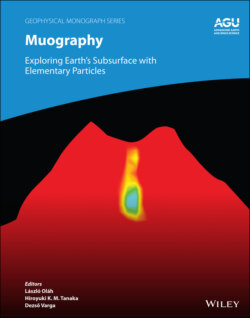Читать книгу Muography - Группа авторов - Страница 48
3.1 INTRODUCTION
ОглавлениеMuography has been established as a tool for mapping the subsurface density profile over the past decade. The application of the technology originated from volcanology (Gibert et al., 2021; Lo Presti et al., 2021; Macedonio et al., 2021; Oláh & Tanaka, 2021; Tanaka, 2021; Tioukov et al., 2021) and it has spread to various targets: natural caves (Hamar et al., 2021); glaciers (Scampoli et al., 2021); underground monitoring (Thompson et al., 2021); mining (Schouten et al., 2021); block landslides (Hernández et al., 2016); etc. Muography is based on the attenuation of the flux of cosmic‐ray muons when they traverse the surveyed targets. The rate of attenuation yields the information on the density distribution, specifically the density integrated along the lines of sight, which is referred to as density length or opacity (Tanaka, 2021). When a measurement is performed with a single detector, it only provides a two‐dimensional map in an angular space, which lacks the resolution along the depth dimension. In the case of volcano monitoring, such a two‐dimensional map can be used to specify on which lines of sight a volcanic conduit may exist. However, the exact location on the line or the size of the conduit cannot be determined from single‐detector measurements.
Tanaka et al. (2010) demonstrated that the limitations of single‐detector muography can be overcome by surrounding the mountain with multiple detectors. They installed two scintillation‐type detectors on the northern and eastern flank of Asama Volcano, Japan, and solved the three‐dimensional density distributions with a scheme of a regularized linear inversion. This sort of measurement is analogous to a medical computed tomography scan, where X‐rays pass through the patient's body from multiple projections. However, in the case of muography, it is often difficult to fully cover the mountain, due mainly to practical reasons, such as cost, logistics, and labor.
Surface gravity data can complement the weaknesses of muography. The measurement of gravity acceleration on the Earth’s surface has been used for multiple purposes. The surface gravity data has been used to determine the shape of the geoid, the equipotential surface of the Earth (e.g., Hoffmann‐Wellenhof & Moritz, 2006). Surface gravity data takes an important role in the exploration of mineral deposits and oil accumulation (e.g., Parasnis, 1976). Gravity anomaly maps provide knowledge of the internal structure of volcanoes and calderas (e.g., Scandone, 1990; Yokoyama & Ohkawa, 1986). Temporal gravity changes are used to study the movement of mass associated with volcanic eruptions (e.g., Battaglia et al., 2008; Van Camp et al., 2017; Carbone et al., 2007; Okubo, 2020).
Since the gravity acceleration on the surface reflects the gravitational attraction by mass of the Earth, it contains the information on the density distribution in the near‐surface. The information, whose sensitivity is different from the one of muography, could be used to improve the resolution of muography imaging. The idea was formulated in a scheme of linear inversion by Davis & Oldenburg (2012) and Nishiyama et al. (2014) performed the demonstration with an actual observation. Simultaneously, a non‐linear and exact formulation was provided by Jourde et al. (2015). Rosas‐Carbajal et al. (2017) performed a linear inversion to a huge gravity/muography dataset taken on La Soufrière de Guadeloupe lava dome. Cosburn et al. (2019) applied the joint inversion to the gravity data taken underground. The formulation of the joint inversion was further developed by Lelièvre et al. (2019), which allows the use of unstructured (tetrahedral) meshes and takes a density bias (discussed later) into account. Methodology for choosing hyper‐parameters was investigated by Barnoud et al. (2019). This chapter introduces a simple formulation by Davis and Oldenburg (2012) and Nishiyama et al. (2014) and reviews the aforementioned technical developments.
Figure 3.1 (Left) Gravity observation. The white instrument in front of the operator is a Lacoste & Romberg relative gravimeter. Behind the operator stands the antenna for Global Positioning System. (Right) Muography observation at Mt. Showa‐Shinzan lava dome (Japan) with nuclear emulsion films.
